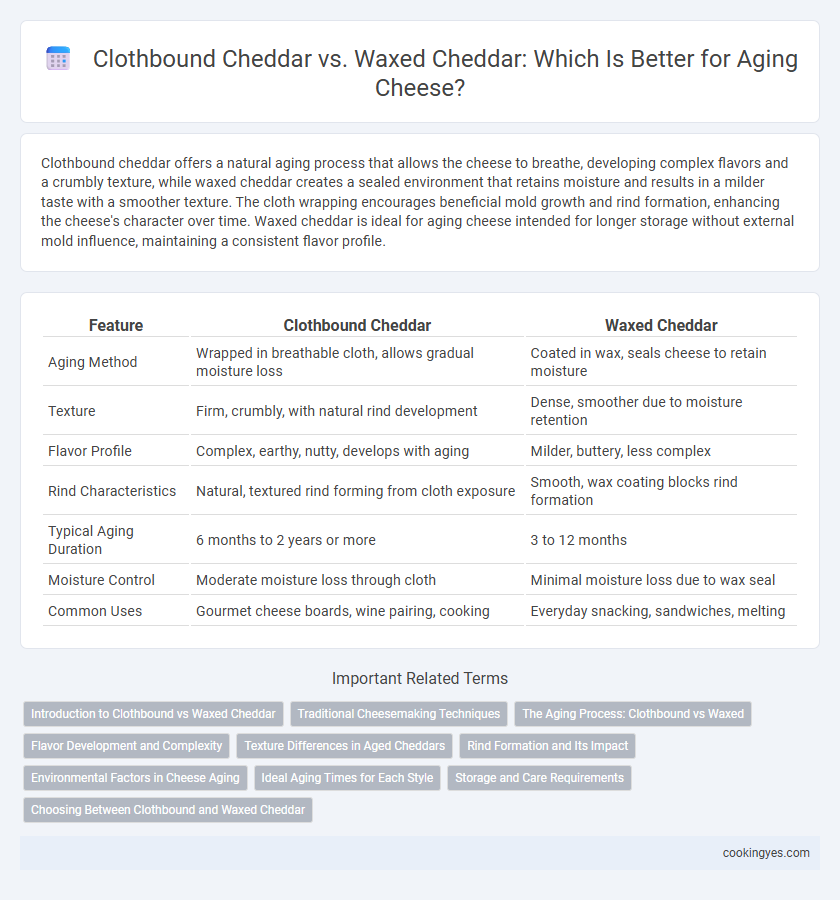Clothbound cheddar offers a natural aging process that allows the cheese to breathe, developing complex flavors and a crumbly texture, while waxed cheddar creates a sealed environment that retains moisture and results in a milder taste with a smoother texture. The cloth wrapping encourages beneficial mold growth and rind formation, enhancing the cheese's character over time. Waxed cheddar is ideal for aging cheese intended for longer storage without external mold influence, maintaining a consistent flavor profile.
Table of Comparison
| Feature | Clothbound Cheddar | Waxed Cheddar |
|---|---|---|
| Aging Method | Wrapped in breathable cloth, allows gradual moisture loss | Coated in wax, seals cheese to retain moisture |
| Texture | Firm, crumbly, with natural rind development | Dense, smoother due to moisture retention |
| Flavor Profile | Complex, earthy, nutty, develops with aging | Milder, buttery, less complex |
| Rind Characteristics | Natural, textured rind forming from cloth exposure | Smooth, wax coating blocks rind formation |
| Typical Aging Duration | 6 months to 2 years or more | 3 to 12 months |
| Moisture Control | Moderate moisture loss through cloth | Minimal moisture loss due to wax seal |
| Common Uses | Gourmet cheese boards, wine pairing, cooking | Everyday snacking, sandwiches, melting |
Introduction to Clothbound vs Waxed Cheddar
Clothbound cheddar features a natural, breathable cloth wrapping that allows slow moisture evaporation and flavor development during aging, resulting in a complex, earthy profile. Waxed cheddar is sealed with paraffin or food-grade wax, preserving moisture and producing a milder, creamier texture with less depth of flavor. The choice between clothbound and waxed cheddar directly impacts the cheese's texture, moisture content, and aging characteristics.
Traditional Cheesemaking Techniques
Clothbound cheddar, aged in breathable cotton cloth, allows natural mold development and moisture evaporation, enhancing complex, earthy flavors through traditional cheesemaking techniques. Waxed cheddar, sealed in a protective wax coating, retains moisture and ages more uniformly but lacks the depth and texture achieved by clothbound aging. Traditional clothbound methods showcase craftsmanship by promoting slow maturation and distinctive rind formation essential to heritage cheddar profiles.
The Aging Process: Clothbound vs Waxed
Clothbound Cheddar undergoes a traditional aging process where natural airflow through the breathable cloth rind promotes complex flavor development and a firmer texture. Waxed Cheddar, sealed in an impermeable wax coating, retains moisture but limits exposure to air, resulting in a milder taste and softer consistency. The choice of aging method significantly influences the cheese's flavor intensity, texture, and rind characteristics.
Flavor Development and Complexity
Clothbound Cheddar undergoes natural aging with breathable fabric, promoting moisture evaporation and mold growth that intensify flavor complexity and develop earthy, nutty notes. Waxed Cheddar, sealed with a protective wax coating, retains moisture and ages in a controlled environment, resulting in a milder flavor profile with less pronounced tang and depth. The porous clothbound rind enables dynamic microbial activity, which significantly enhances the maturation process and produces richer, more nuanced tastes compared to the more uniform aging of waxed variants.
Texture Differences in Aged Cheddars
Clothbound Cheddar develops a complex, crumbly texture due to its breathable cloth wrapping that allows moisture evaporation and natural mold growth. Waxed Cheddar retains more moisture inside the wax coating, resulting in a smoother, creamier texture with less crumbliness. The aging environment and wrapping method significantly influence the mouthfeel and textural complexity of the final cheddar cheese.
Rind Formation and Its Impact
Clothbound Cheddar develops a natural, breathable rind that allows controlled moisture loss and microbial activity, enhancing complex flavor and texture during aging. Waxed Cheddar, sealed in an impermeable wax coating, prevents rind formation and limits exposure to air, resulting in a more consistent but less nuanced maturation. The choice between clothbound and waxed aging directly impacts the rind's permeability, which influences the cheese's aromatic profile and aging depth.
Environmental Factors in Cheese Aging
Clothbound cheddar ages with improved breathability, allowing natural microbial activity that enhances complex flavor development, while waxed cheddar's sealed environment restricts airflow, slowing maturation and preserving moisture. Environmental factors such as humidity and temperature stability are crucial for clothbound aging, preventing unwanted mold growth and promoting rind formation, whereas waxed cheddar is less sensitive to these variables due to its protective coating. Choosing clothbound or waxed cheddar impacts the cheese's interaction with aging conditions, influencing taste, texture, and environmental sustainability during the maturation process.
Ideal Aging Times for Each Style
Clothbound Cheddar typically benefits from an aging period of 9 to 24 months, allowing the natural rind to breathe and develop complex flavors and a firm texture. Waxed Cheddar, sealed with a protective wax coating, is best aged for 6 to 18 months, which helps retain moisture and produce a milder, creamier profile. Proper aging times influence the balance of sharpness and texture unique to each style, with clothbound aging promoting earthy undertones and waxed aging preserving smoothness.
Storage and Care Requirements
Clothbound Cheddar requires breathable storage conditions to allow proper aging, typically wrapped in cheesecloth and kept in a cool, humid environment to develop complex flavors and maintain rind integrity. Waxed Cheddar benefits from the protective, moisture-sealing wax coating, enabling longer storage without direct exposure to air, but it must be kept in stable, cool temperatures to prevent sweating and spoilage. Proper care for both types involves regular inspection for mold and avoiding excessive drying or moisture to preserve texture and taste during aging.
Choosing Between Clothbound and Waxed Cheddar
Clothbound cheddar offers a natural aging process that allows the cheese to breathe, developing complex flavors and a firm, crumbly texture favored by artisanal cheese enthusiasts. Waxed cheddar, sealed in paraffin wax, retains moisture and prevents mold, resulting in a milder taste and softer texture ideal for longer storage and consistent quality. Selecting between clothbound and waxed cheddar depends on desired flavor intensity and aging environment preferences.
Clothbound Cheddar vs Waxed Cheddar for Aging Infographic

 cookingyes.com
cookingyes.com